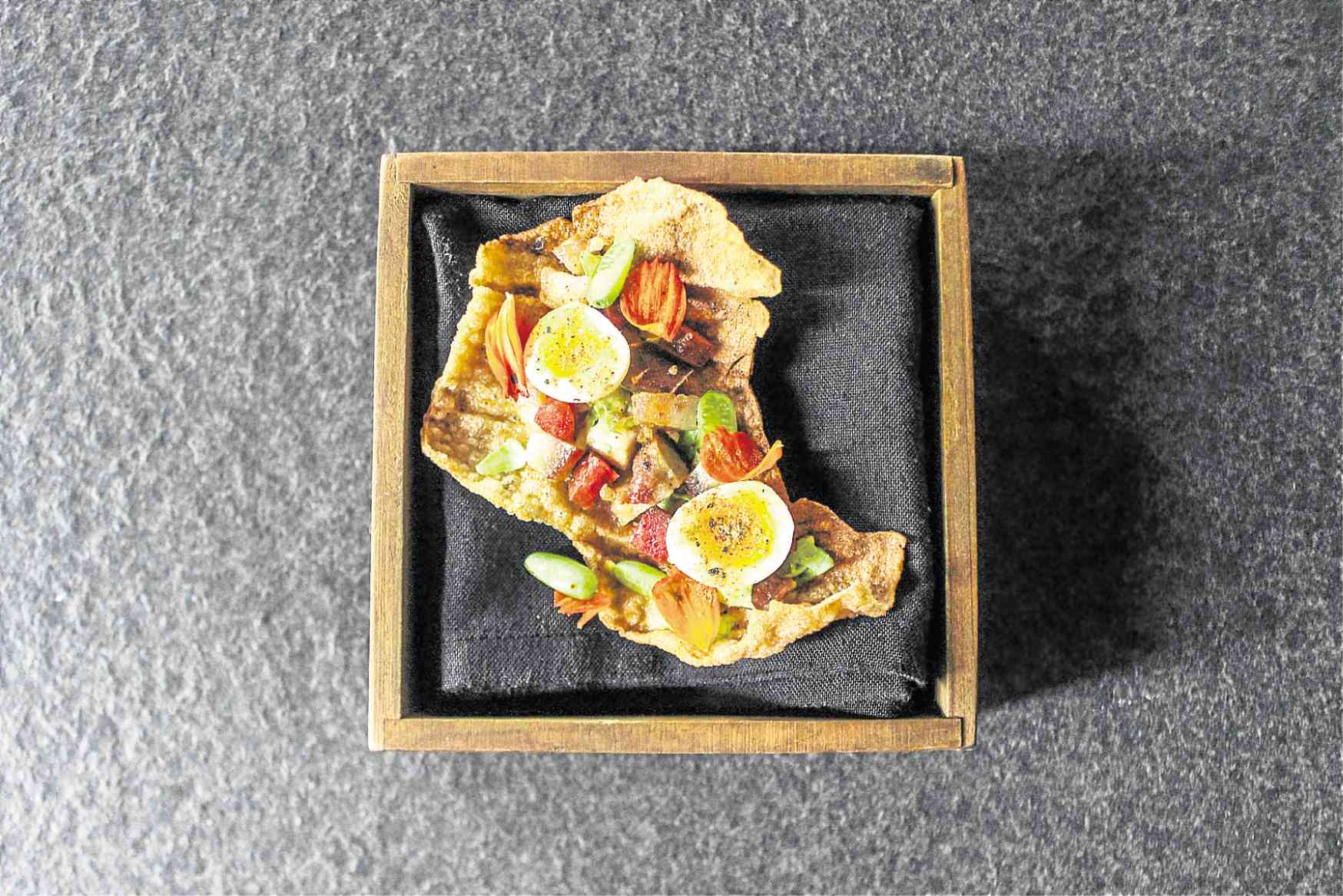(Last of two parts)
Vietnam’s pho by Kalel Chan
As proven by the satisfying food at Kabila and M Café, two of the restaurant kitchens he manages, Kalel Chan knows how to play with tradition without ending up being superficial.
He shows a similar flair in his adaptation of the Vietnamese staple. “The broth in pho is very light. When you taste it, you’ll be able to distinguish the beef flavor, similar to that of bulalo,” he says.
He uses the local beef shank and marrow stew for Vietnam’s pho, and with the help of toasted spices, comes up with a hearty, intensely flavored noodle soup.
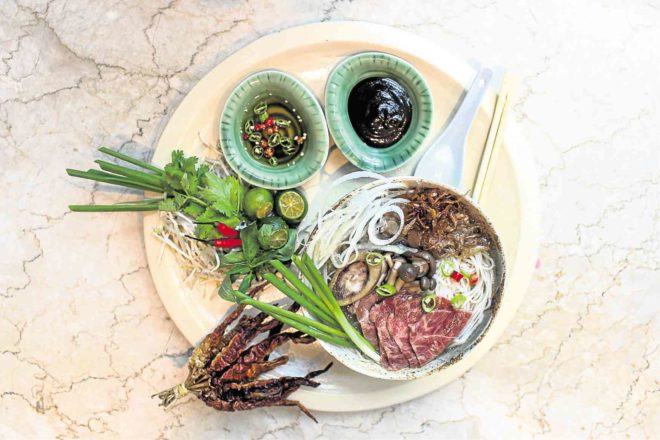
Bulalo Pho with Wagyu Top Blade
Boil 34 oz of water in a medium-size sauce pot. Add 2 lbs of beef shank, followed by 2 medium onions and 1 tsp whole peppercorns. Simmer for 1½ hour, or until meat is fork tender. Set aside.
Toss ½ tsp fennel seed, ½ tsp coriander seed, 1 small stick cinnamon and ½ tsp cloves in a dry saucepan, stirring and tossing frequently over medium heat, until they begin to smell toasty and fragrant.
Transfer spices to a pot. Pour about 11 oz of beef stock together with 1 tbsp shiitake mushrooms. Simmer. Season with 2 tbsp fish sauce and 1 tbsp sugar.
In a 6- to 8-quart pan over high heat, bring 6 c of water to a boil. Add 3 oz rice noodles and stir to separate. Cook until barely tender to bite. Slice 3 oz wagyu top blade into about ¼-inch pieces.
To assemble: Divide rice noodles evenly between serving bowls. Add broth, top with mushrooms, wagyu beef, spring onions, white onions, chilies and fried shallots. Serve with bean sprouts, green finger child, red bird’s eye child, fresh cilantro, Thai basil, calamansi, hoisin sauce and fried shallots on the side.
Myanmar’s ‘mohinga’ by Kalel Chan
A street hawker favorite, the mohinga is a noodle soup that has the faint flavor of fish. For his rendition, the Raintree Group’s corporate chef Kalel Chan cranks up the essence and aroma of catfish by transforming the usual hard-boiled egg into a Scotch egg.
Instead of sausage meat casing, he uses fish mousse. To add extra spice and local touch, he throws in a sambal from Mindanao called the palapa, both in the broth and the Scotch egg.
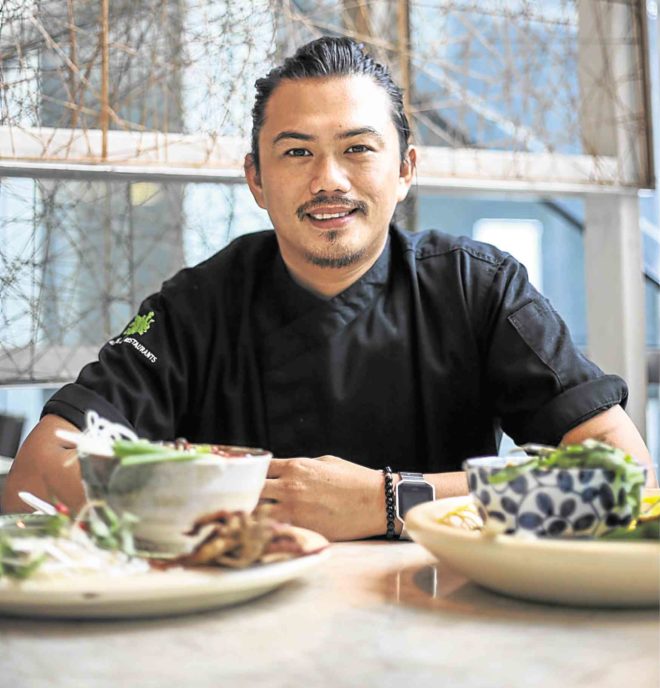
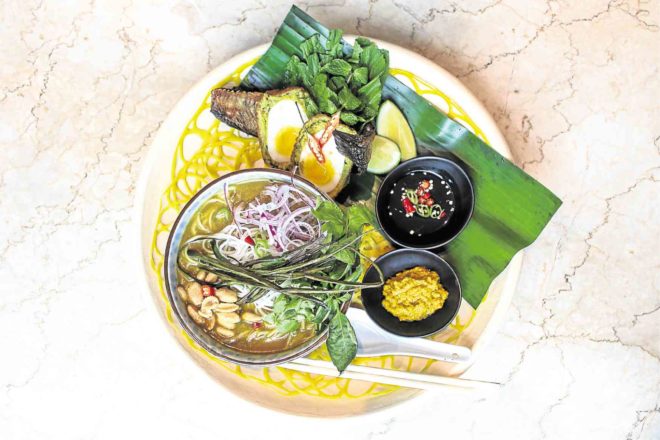
Mohinga with Catfish Palapa Scotch Eggs
In a large saucepan, prepare broth by bringing 10 c of water to a boil. Add 2 tsp dashi powder and 2 tbsp fish sauce. Add 3 pounded lemongrass stalks and 1 medium catfish fillet. Simmer for 10 minutes or until fish is cooked through. Set aside.
In a medium-size skillet, heat 6 tbsp oil. Add 2 medium chopped onions, 5 cloves peeled garlic, and chopped lemongrass. Sauté for 3-4 minutes.
Add 3 tsp turmeric, 2 tsp paprika, 1 tbsp fish sauce. Season, stirring occasionally for 5 minutes.
Meanwhile, remove fillet from pot. Chop fish as thinly as possible. Add to sautéed spices. Cook for 8 minutes. Place sautéed spices into broth. Boil.
Add 5 tbsp fish sauce and 8 tbsp rice flour. Simmer for 10 minutes or until thickened. Set aside.
In a 6-quart pan over high heat, bring 6 c of water to a boil. Add rice noodles and stir to separate. Cook until barely tender to bite, about 2-3 minutes.
To make palapa, combine 1 tbsp chopped white onion, 1 tbsp minced garlic, 1 tbsp turmeric, 1 tbsp chopped lemongrass, and 1 tbsp ginger in a food processor. Process until fine. Set aside. Steam 1 medium catfish fillet and flake. Set aside.
In a small sauce pot, boil egg for 6 minutes and place in an ice water bath. Remove shells. To assemble Scotch egg, combine flaked catfish and 1/2 tbsp palapa. Mix well.
Spread mixture on a cling fling, place egg at the center. Cover with mixture, then wrap. Chill Scotch egg for 5 minutes. Deep fry until golden brown.
To assemble: Divide cooked rice noodles evenly between serving bowls. Add broth, top with red onions, sliced Scotch egg, peanuts, cilantro and fried shallots. Serve.

Laos’ ‘larb’ by Jorge Mendez
Jorge Mendez of Alta at Ascott Bonifacio Global City finds larb, the national dish of Laos, to have too many elements, that it may pose to be a challenge to eat.
For convenience, he transforms the Laotian meat salad into a hand-held dish by using cabbage as a cradle for minced wild boar sweet bread.
The colors make it a stunner, while the presentation is nothing short of elegant. As for the flavor, it’s a beautiful balance of sweet, spicy and sour, which is evidence of Mendez’s talent.
Wild Boar Sweetbread Larb with Sweet Shrimp Lime Paste and Edible Pork and Cashew Film
Season 300 g sweetbreads with salt and pepper. Sear all sides in a hot stock pan. Add water until meat is submerged. Boil and simmer for 2 hours. Strain pork and mince. Set aside.
In a pan, saute 10 g garlic, 10 g red onion and 10 g ginger in vegetable oil for 2 minutes. Add meat and season with ½ tsp fish sauce, ½ tbsp sugar, ½ tsp shrimp paste, juice from 2 wedges, and torn mint and basil. Mix until combined. Add 30 g each of thinly sliced cucumber and carrots.
To make sweet shrimp lime paste, combine 15 g Thai shrimp paste, 4 tbsp honey, 1 tbsp brown sugar, juice of half a lime wedge and ¼ pc red chili. Cover and chill.
To make edible pork film, mix ½ c pork jus, 3 g anthem gum, 10 g shaved cashew nut, 30 g brown sugar, 5 g hoisin sauce and a pinch of salt. Transfer to a pan. Simmer. Reduce until pasty. Spread thinly on a split and dehydrate at 65oC for two hours.
To assemble: Place sweetbread mix on blanched red cabbage. Garnish with purple basil, pickled shallots, red and green chilis, sweet shrimp lime paste and top with edible pork film.

Brunei’s ‘ambuyat’ by Jorge Mendez
Typically, the way to eat ambuyat is to allow the thick tapioca starch to cling to the prongs of a bamboo stick called chandas dipped in a variety of sauces because it’s tasteless.
Jorge Mendez changes the manner it is to be enjoyed by grabbing a portion of each of the components on his plate, then popping them in the mouth, offering textures apart from a gluey mass.
Tapioca curd has been seasoned with asam rebus broth, while chili jam is equal parts sweet and spicy, making it friendlier to Pinoy palate.
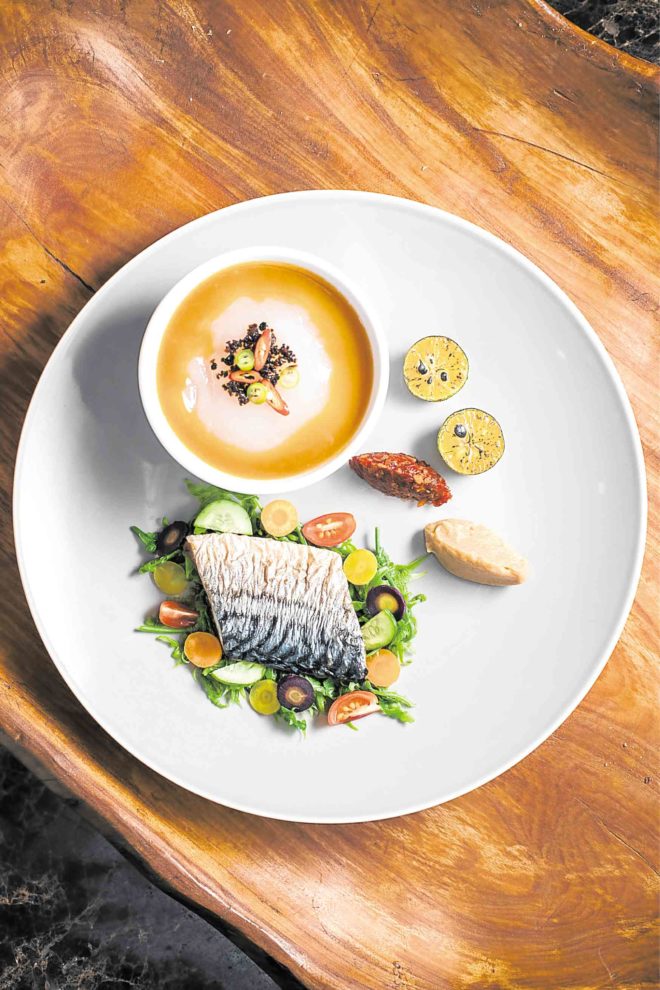
Tapioca Curd with Asam Rebus broth, Seared Mackerel, Chili Jam and Sambal Tempoyak Paste
Make tapioca curd by mixing 50 g tapioca flour and 100 ml hot water. Whisk with fork until well incorporated. Let cool.
To turn into crumbs, strain 30 g, bagging it until all oil is drained. Roast until toasted.
For chili jam, roast 25 g tomato paste in vegetable oil. Add 40 g sambal olek, 50 g garlic chips, 2 g brown sugar, ¼ tsp salt and ¼ tsp black pepper. Mix well. Set aside.
Make sambal tempoyak paste by mixing 50 g durian meat, 1 tsp shrimp paste, 1 ½ tbsp brown sugar, ½ pc red chili, and a pinch of salt. Transfer to a pan. Simmer. Reduce until pasty. Let cool.
Lay pan-seared mackerel fillet on a bed of pako fern. Garnish with thinly sliced cucumber, carrots and chilis. Serve with chili jam, sambal, burnt calamansi, and tapioca cured with asam rebus broth.

The Philippines’ ‘adobo’ by Patrick Go
Interpreting the Philippines’ world-famous dish, Black Sheep’s Patrick Go wanted to give adobo a different mouthfeel while retaining its familiar flavor.
In line with his restaurant’s fusion offerings, he added 5-spice powder to the braise to give it a subtle floral medicinal taste that Chinese cuisine is known for.
Less of a stew and more of a fried dish, his take also relies on fermented black garlic for a bolder, intensified “adobo” flavor, while the sour notes come in an airy foam, which is very reflective of his modern style.
Twice-cooked Pork Belly Adobo with Fermented Garlic and Sinamak
Slice 500 g pork belly into 2×2-inch cubes. Sear each piece in a pan. Set aside.
Saute 50 g chopped onion and 50 g garlic in deep pan with oil. Add pork belly and 1 tsp 5-spice powder. Pour 70 ml soy sauce and 1 L water in pan. Add 60 ml vinegar. Simmer for 2 hours, or until meat is tender. Strain meat. Set aside.
Combine 40 g black garlic, 20 ml soy sauce, 300 ml water, a bay leaf and 12 g sugar in a small pot. Simmer until reduced. Blend until smooth. Combine 50 ml sinamak and 1 tsp soy lecithin. Blend with hand blender. Set aside.
Combine 50 g potato starch and 50 g cornstarch. Coat meat with starch mixture. Fry in 180ºC oil.
Transfer to plate. Blend sinamak mixture until foamy. Gently put foam on fried pork belly. Place a dollop of black garlic sauce and reduced adobo sauce on the side. Dust plate with onion ash. Serve.
Indonesia’s ‘nasi goreng’
Like many of his dishes at Black Sheep, Patrick Go reimagines Filipino-Chinese fare using contemporary techniques.
He uses the same approach in his version of the all-time favorite nasi goreng.
Fried rice has a different form, as a fried cracker, topped with smoked pork belly, lap cheong sausage and a bit of tamarind paste.
He adds soft-boiled quail egg to the mix, as substitute for the original dish’s fried egg.
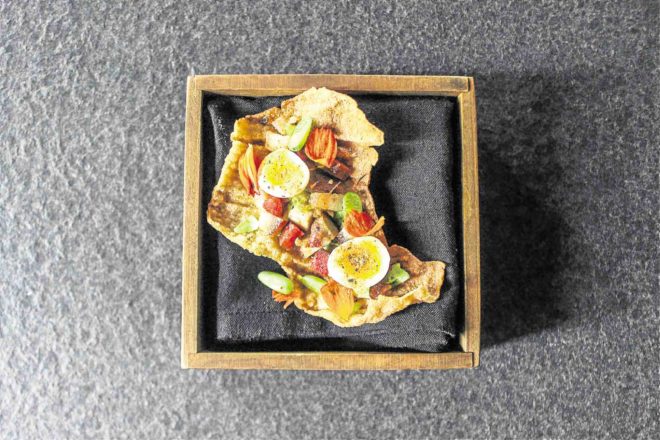
One-Bite Nasi Goreng
Boil 50 g rice and 400 ml water until mushy. Puree in blender. Add 20 ml oyster sauce and 1 tsp seafood powder. Pour in a container with parchment paper. Put in dehydrator or low temperature oven and dehydrate for 3 hours. Break into small pieces. Deep fry at 190ºC until it puffs up. Set aside.
Light up a coconut husk in a food pan. Place 100 g pork belly on top of a perforated screen, cover and smoke for 1 hour.
Cut 2 pc lap cheong sausage into small cubes. Boil 8 pc quail eggs for 95 seconds. Shock in ice bath. Peel. Set aside.
Salute 50 g onion and 15 g garlic. Add smoked pork cut into cubes, lap cheong, 10 g tamarind paste, 5 g sugar and half a piece of child chopped.
Put on top of rice cracker. Garnish with sliced quail egg and baby cucumber. Serve. –CONTRIBUTED

